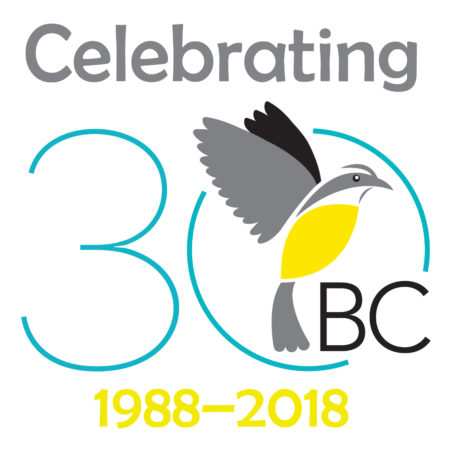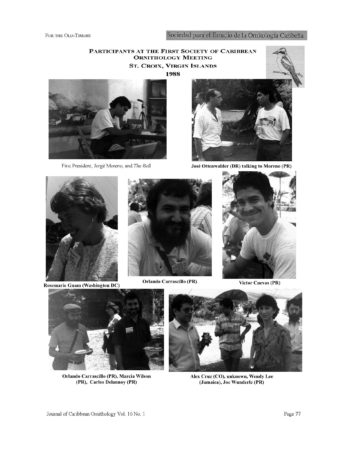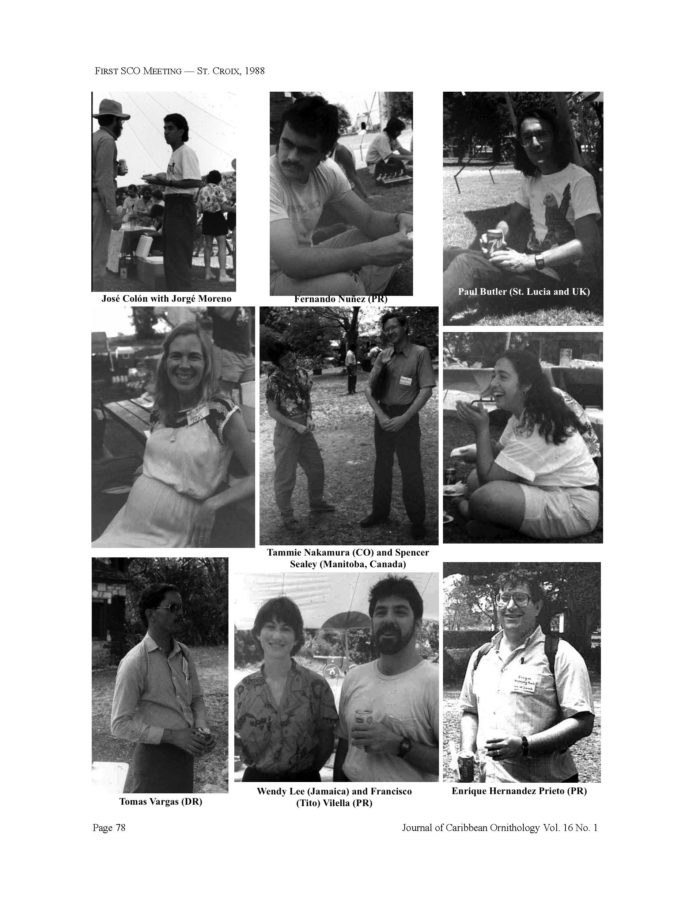BirdsCaribbean has “come of age,” and is saying goodbye to its youthful twenties. It is thirty years old this year! While taking a glance behind us, to see how far we have come, we are also looking forward to the opportunities and challenges that lie ahead.
A Short History of Us

So how did BirdsCaribbean come into being? Well, the first official meeting of the Society of Caribbean Ornithology (SCO) took place in St. Croix, U.S. Virgin Islands back in May, 1988. However, its roots go further back, when first President Jorge Moreno, then head of terrestrial ecology in Puerto Rico’s Department of Natural Resources, met up with Dr. Herb Raffaele, who was then the U.S. Fish and Wildlife Service’s (USFWS) Project Officer for Latin America and the Caribbean. These were two of the “Founding Fathers.” Moreno and Raffaele joined forces and invited “estudiantes de las aves” (students of birds) from around the Caribbean to a meeting in Puerto Rico, funded by USFWS. The following year there was another meeting. After these successes it was clear that they were onto something. They decided to create a new entity, and in 1988 the SCO was formed.
The First Meeting: Bedsheets for Blinds
Who were these “students of birds,” and what was the very first meeting like? Founding Fathers ornithologists Dr. Joe Wunderle and Dr. Herb Raffaele and José Colón described the first meeting as attracting a group of biologists, scientists and conservationists. They saw the study of birds as an avenue to advance their research, management and conservation goals. The meeting in St. Croix took place on an old sugar estate – and was not without its challenges. The building had no air conditioning and the windows had no shades or blinds, so some participants removed the sheets from their beds and covered the windows, to darken the room for presentations. However, it was very windy and this didn’t work so well. No one had been designated as the projectionist, so Wunderle’s wife, Dr. Jean Lodge, volunteered to run the slide projector.

Bear in mind there was no PowerPoint in those days! Nor Internet, nor any of the luxuries and conveniences of technology that we now enjoy at our meetings. There were also no simultaneous translations, so volunteers provided short translations after each presentation. Besides, the programs for each annual meeting were fluid, to say the least. Some speakers were “no shows,” others turned up unexpectedly. And scheduling of Cuban participants was especially challenging given uncertainty as to who would actually receive permission to attend. Needless to say, participants in the early days learned to expect the unexpected. Fortunately everyone was adaptable.
Rosemarie Gnam (former Treasurer) shared one fond memory of this first meeting: After going out to dinner one night in St. Croix, participants found themselves locked out of the small hotel where most of them were staying. Jorge and others scaled the tall fence to gain access – and eventually they got a good night’s sleep.
Herb Raffaele shared another fun memory from the early days of the society: “Our earliest Caribbean bird conservation meetings, begun in the late 1980’s, were relatively simple affairs. All of the planning and organizing was done by Jorge Moreno of the Puerto Rico Department of Natural Resources and all the funding for delegates from throughout the Caribbean was provided by the Latin America and Caribbean program of the U.S. Fish and Wildlife Service. Everything was done on a shoestring budget, something in the order of $20,000, so corners were minimized at every opportunity. At one such meeting in Puerto Rico I remember driving up to the meeting site only to find this ratty old facility, completely rundown, surrounded by a towering cyclone fence that had to be scaled because no one had a key to its locked gate. When I queried Jorge about this choice of locations he reminded me with great satisfaction how this facility was such a bargain – it scarcely cost more than two dollars per night per person! However, after some attendees later heard gun shots, I suggested to Jorge that future budgets should allow more for accommodations. We have never met in such an inhospitable place again.”
Launching our 30thAnniversary on Video
Along the way, the largest conservation non-profit organization in the Caribbean has changed its name twice. It was incorporated as a non-profit organization in the U.S. in 2003 as the Society for the Conservation and Study of Caribbean Birds (SCSCB). Then, in 2013, following deliberations at the International Conference in St. Georges, Grenada, it was reborn as BirdsCaribbean.
While looking back nostalgically at the early days, Joe Wunderle observes: “Now the Society has grown tremendously and has active outreach and education programs, training programs, including training of field biologists, bird guides, and more…We have got young people who are coming to our meetings and taking leadership roles in the society.” We hope that Joe would not call himself an “old fossil,” however. We would prefer to describe him and his colleagues from the 1980s as “pioneers.”
We are delighted to launch our 30thAnniversary celebrations – starting with the accompanying video from Joe Wunderle himself, talking about how BirdsCaribbean has evolved over the past three decades. More memories, stories and videos will follow!
Share your Memories!
If you have fun memories or old photos to share, please send them to: Lisa.Sorenson@BirdsCaribbean.org.
Many thanks to Joe Wunderle, Herb Raffaele, Rosemarie Gnam, Jose Colon and Emma Lewis for help with this article! Thanks also to Esther Figueroa (Vagabond Media in Jamaica) for putting together this video for us and to Jerry Bauer for videography. Photographs in the video are by Frantz Delcroix (Magnificent Frigatebird) and Rafael Arvelo (Hispaniolan Parakeets). Our cartographer, Aly DeGraff Ollivierre created our 30th Anniversary logo.

